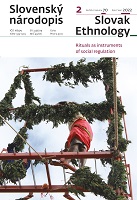Rituals and Group Solidarity: An Ethnographic Case Study
Rituals and Group Solidarity: An Ethnographic Case Study
Author(s): Andrej MentelSubject(s): Cultural Anthropology / Ethnology, Culture and social structure , Social Theory, Sociology of Culture
Published by: Ústav etnológie a sociálnej antropológie Slovenskej akadémie vied
Keywords: Ritual; group solidarity; synchronization; rhythm; commitment signalling;
Summary/Abstract: Since Durkheim (2002 [1912]), it has been recognised that ritual can serve as a means of strengthening intra-group solidarity. Mutual help and emotional arousal connected with rituals may help the participants cope with adversities. Collective rituals have thus become one of the tools for adapting to environmental conditions. Several theories try to clarify the mechanism by which this adaptation happens. One’s investment of time, money, and other personal resources into collective activities, including rituals, may serve as a commitment signal and thus enhance group solidarity. However, rituals are not the only way the group members signal their commitment. Therefore, the fundamental question is whether rituals offer anything unique compared to other types of joint coordinated activity. Atran and Henrich (2010) provide a hypothesis based on some of the characteristics of rituals that observed all over the world. According to them, religious rituals often involve various components to promote faith and devotion by stimulating certain emotions. The primary tools in this context are music, rhythm, and synchronization of body movements. In this ethnographic case study from Bosnia, I compare three confessional communities (Sunni Muslims, Roman Catholics, and Sufi dervishes). They inhabit the same geographic area but differ in the character of their ritual performances regarding synchronization and use of rhythmic activities. The highest degree of in-group solidarity is expected in the group whose rituals involve rhythm and synchronization of body movements to the greatest extent.
Journal: Slovenský národopis
- Issue Year: 70/2022
- Issue No: 2
- Page Range: 228-247
- Page Count: 20
- Language: English

